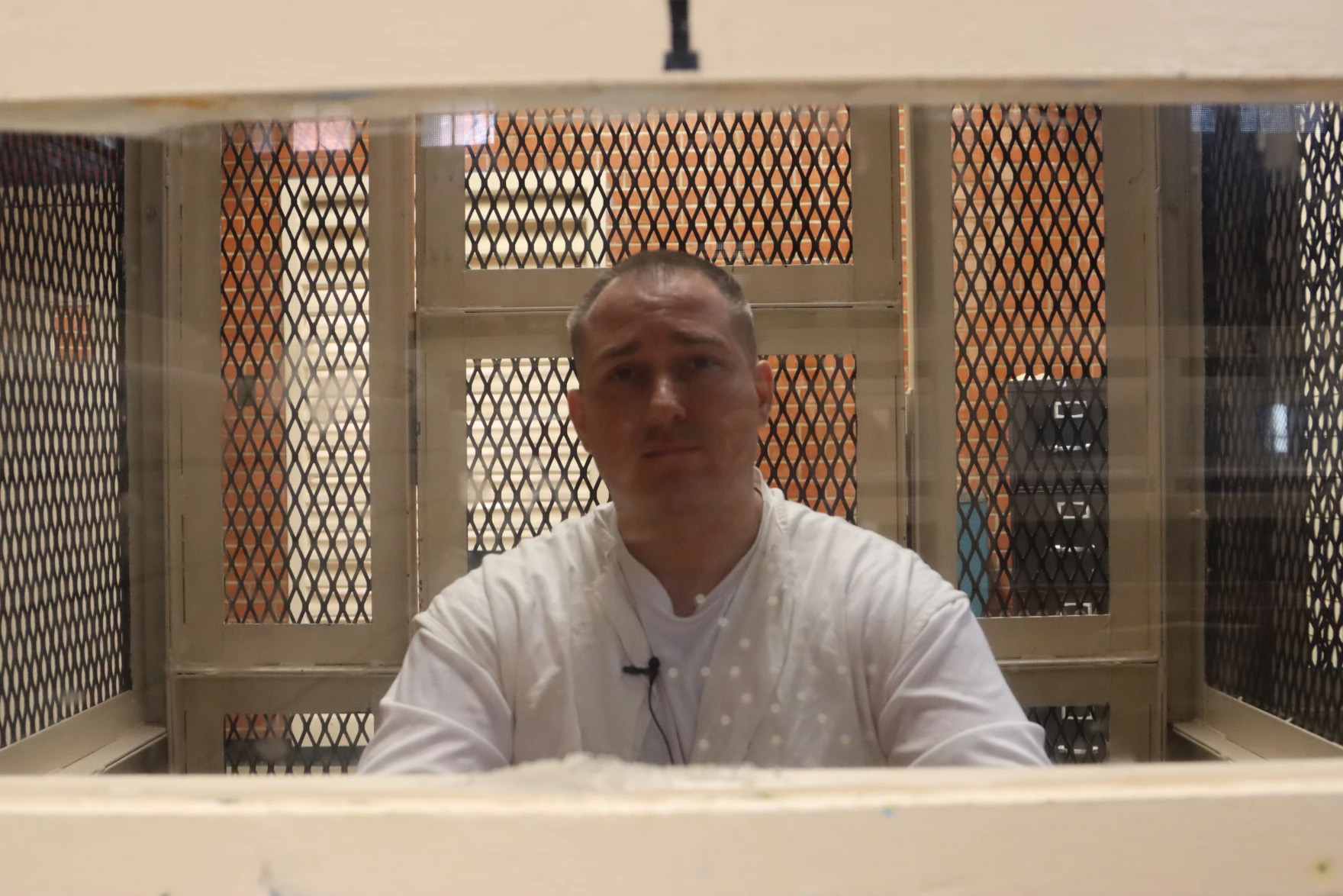From Texas Public Radio:
Tim Nixon knew something bad was about to happen.
It was 9:15 p.m. on Sept. 5, and he had just been rousted from his cell by three guards whose names he didn’t know and whose name tags he said were obscured by full tactical riot gear.
The barking orders, the stiff, palpable tension, and the time of night told Nixon he needed to do as he was told and keep quiet. So, clad in just his boxers, he complied.
Nixon said they placed him in a holding cell about 40-50 feet down the hall directly across from another cell — cell number 1. Then the guards joined a half dozen others lined up outside cell 1.
“Call it intuition, call it whatever you want, you can tell that somebody is fixing to get their ass whooped,” said Nixon, a man who has served more than 30 years in Texas prisons.
The Alternative Living Unit or ALU where Nixon currently lived at Coffield Unit holds 12 men — often convicted of violence — in solitary confinement who have a high risk of escape or who have assaulted guards in the past, people like the occupant of Cell 1, Kiheem Grant.
“I’m literally 20 feet away in this holding cell. And I can see Grant in his cell,” he recalled. And he was the only inmate who could see in the cell, as all ALU cells abut one wall.
What Nixon had not seen was that an hour before Grant assaulted an officer, according to state documents.
A feud between Grant and a new sergeant boiled over according to inmates. Grant, who was in prison for murder, already had issues with authority and wasn’t opposed to lashing out. He reportedly attacked a witness at his own trial in front of the jury.
“From my experience with him, he’s never been a violent person just because he can. You have to push him and the thing is it doesn’t take much push,” said Harold Laird, an inmate who lived on the same wing at the time.
And Laird said Sergeant Gabriel Kweh had been pushing.
Kweh couldn’t be reached for comment, but he had recently been promoted and moved to ALU. Inmates like Laird said Kweh kept making mistakes like bringing food men to men who were allergic to it. and refusing to correct it. He antagonized the inmates who — like Laird — are often murder convicts.
“So he really didn’t know what to do. We were trying to tell him, Look, this is how you do things. But we’re inmates, we can’t tell him what to do,” he said.
Kweh and Grant did not like one another, said Laird, and things had been simmering since the sergeant arrived two weeks prior. That night, a verbal altercation between the men escalated.
“And then he shot him in the neck with a spear right then and there,” he said.
Laird admits he didn’t see this happen. But he and other inmates were told Grant had fashioned some sort of gun and shot some sort of arrow or sharp object at Kweh through the one inch holes in their steel doors.
Laird did see the blood.
“I came to the door and I looked and I’d seen little splatters of blood on the run,” he said.
The officer was briefly hospitalized, but TDCJ did not release details of his condition citing privacy laws.
This was why Nixon, himself a recent transfer from another unit, had been moved. His cell, number 12, had plexiglass over the holes, preventing objects from being pushed (or shot) through. The idea was to swap the cells of Grant and Nixon.
About 10 minutes after Kweh had been attacked, a major showed up. Laird heard Grant say that he knew guards needed to come into his cell to take his weapon and that he wouldn’t resist.
Multiple inmates said 45 minutes later, an extraction team of about nine guards— larger than the standard five — with pads and masks showed up with an additional supervisor and an officer filming the extraction.
The guards handcuffed Grant behind his back through the door — which in this unit is two pairs of cuffs, a small protective black box that slides over one pair of cuffs preventing access to the keyhole. A chain is wrapped around these and a padlock is used to secure the mass of bindings.
Guards then told Grant to get on his knees.
At this point inmates expected retaliation by guards.
“They’re gonna get theirs,” said Laird. “But I mean, this is prison, what do you expect?” he asked.
But no one expected what they heard and — in Nixon’’s case — witnessed.
“They open the door and run in and proceed to beat the crap out of this guy. Beat the living crap out of this guy,” Nixon said.
Nixon recalled guards holding Grant’s limbs while three began beating him. They used their fists, one used his shin guard. Then he said he saw something he had never seen before in three decades of incarceration: a guard removed his helmet and raised it up.
“It’s just missing the ceiling by inches,” Nixon recalled holding his own hand high over his head.
“He’s raising it eight and a half, almost nine feet up and…” Nixon slammed his fist against the table in front of him in the small visitation cage for effect, “bringing it down on offender Grant’s head multiple times.”
Grant was passed out, but — according to Nixon — they kept hitting him.
“This guy was just completely unresponsive, I mean, he’s out cold now and they’re just continuing to beat him,” said Nixon.
Laird, whose cell was next door, said he heard a loud, meaty thump, a sound he described as somewhere between a bat hitting a side of beef and a tree.
“I’ve seen a lot of use of force [incidents] — I’ve been involved in a few. That probably was the most brutal sounding use of force I’d ever heard,” said Laird.
In an email, Servando Gamez Dominguez, another inmate on the wing, said it wasn’t a “use of force.” Instead Guards were “beating him like an animal” and “trying to kill him.”
“You come — even as a convicted murderer — which I am…You come to realize that you’re going too far at some point. And the most alarming thing to me was at no point did anybody stop,” said Nixon.
After it was over, they put Grant on the ground and, despite him being unconscious, a guard continued to hold him down, according to Nixon.
Twenty minutes later, a nurse arrived with a wheelchair, and they loaded him onto it.
“And they had to hold him in the wheelchair because he was totally flaccid his whole body. He was out,” said Laird.
Grant is currently at a prison hospital in a coma that his family says he likely won’t wake from.
He was given a 25% chance of survival in the immediate aftermath, according to his mother, Loretta Grant.
TDCJ still has not identified who was involved, nor provided a narrative of the assault other than that an extraction team trying to remove Grant broke protocol and used excessive force. Seven guards were terminated, and six resigned and a criminal investigation is ongoing.
The inspector general lists Abayomi Ipoola as the sole suspect in the assault on Grant, in a document. He resigned earlier this month.
Twenty-two guards were listed as witnesses on the state document, but many have been identified by inmates as assailants or as involved.
Kevin Calip, Javonte Tramble, Zandrick Morrow, Chelsea Williams, Miraida Pena, Chris High, and Todd Fritz were all suspended as disciplinary processes are completed or as they use up accrued time.
Oluwatosin Olorunfemi, Albert Kwarteng and Wilner Paul also resigned.
TDCJ is currently fighting TPR to keep the disciplinary records of guards involved private.
TDCJ says it began moving away from use of force plans to behavioral intervention plans last year. The plans emphasize verbal commands and de-escalation according to the department.
“All corrections officers receive training on Behavioral Intervention Plan at preservice and in-service training,” said Amanda Hernandez, Director of Communications at TDCJ
Why de-escalation wasn’t used in this incident is unclear.















